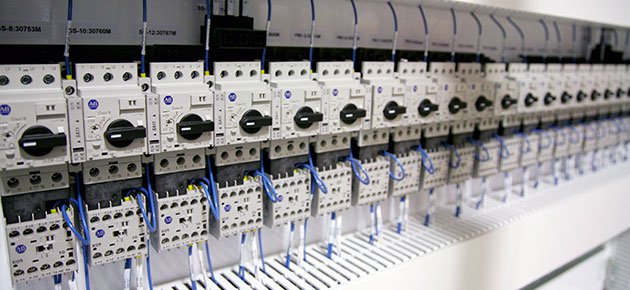
Why and How to Calculate Short-Circuit Current Rating (SCCR)
Jacob Robertson | 28 October 2015
When it comes to your industrial machinery, it’s critical to ensure your electrical panels are designed and built with the proper SCCR to maintain system uptime and employee safety.
SCCR may sound like an acronym for a competitive racing circuit or a certain rock band from the 60/70s. However, fortunately for you, SCCR is way more interesting. It stands for Short-Circuit Current Rating, which is defined in the 2011 NEC (National Electric Code), Article 100 as: “The prospective symmetrical fault current at a nominal voltage to which an apparatus or system is able to be connected without sustaining damage exceeding defined acceptance criteria.” What’d I tell you, way more interesting! Okay, so maybe talking about SCCR is not that exciting, but let’s discuss it in more detail, including why it has become an important topic, today, pertaining to the installation of industrial machinery electrical panels at customer facilities.
Calculating Short-Circuit Current Rating (SCCR)
In more simple terms, SCCR is the maximum short-circuit current an electrical component can safely withstand without causing a shock or fire hazard. Without going into too much detail, the SCCR rating for an electrical panel is based on each electrical components SCCR rating in that panel. Most electrical components have the SCCR rating marked on the component itself. If not, a default value can be assigned by referencing Table SB4.1 in the UL 508A standard. Taking these values and understanding a little more about circuit design (I won’t bore you with detail here), basically, the smallest SCCR-rated component in certain circuits determines the electrical panel SCCR rating.
Why It’s Important for Installation
 Since the release of the 2011 NEC, industrial machinery electrical panels are required to be marked with an SCCR rating. Prior to this, panel manufacturers only had to supply the interrupting rating of the panel overcurrent protective device, or the amperage at which the main disconnect to the panel would “trip”. This means that since the 2011 NEC release, industrial machinery electrical panel manufacturers had to start not only calculating SCCR ratings for their panels, but also understanding the available fault current that is supplied at the customer facility where installation of the panel will be. If the available fault current supplied to the panel is higher than the SCCR rating of the panel, installation of the panel is prohibited by 2011 NEC, 670.5. This requires industrial machinery electrical panel installers to verify the available fault current at their customer facilities.
Since the release of the 2011 NEC, industrial machinery electrical panels are required to be marked with an SCCR rating. Prior to this, panel manufacturers only had to supply the interrupting rating of the panel overcurrent protective device, or the amperage at which the main disconnect to the panel would “trip”. This means that since the 2011 NEC release, industrial machinery electrical panel manufacturers had to start not only calculating SCCR ratings for their panels, but also understanding the available fault current that is supplied at the customer facility where installation of the panel will be. If the available fault current supplied to the panel is higher than the SCCR rating of the panel, installation of the panel is prohibited by 2011 NEC, 670.5. This requires industrial machinery electrical panel installers to verify the available fault current at their customer facilities.
SCCR Compliance
To summarize, two things are important to remember when complying with SCCR ratings.
- The available fault current must be determined at the customer facility where the electrical panel will be installed.
- The SCCR rating of the electrical panel must be equal to or greater than the available fault current determined in #1.
And you thought I was going to bore you with some lengthy article about auto racing or rock n’ roll. Not here! If you have questions regarding Short-Circuit Current Rating or your industrial machinery electrical panels, contact us. We have a full team of controls engineers and panel builders who are happy to help.
Comments
Briggs Electrical says:
5/13/2019 03:14 AM
Any signs of damage with these are common signs of a short circuit, and should be taken as a sign that you may need to buy a replacement very soon.
Michael Andserson says:
7/15/2019 01:08 PM
I need help understanding how to calc these. Also Just some super basic definitions. I understand that the smallest sccr rated component in circuits determines the sccr rating tho.
Leave a Reply
Your email address will not be published.
Comment
Thank you for your comment.